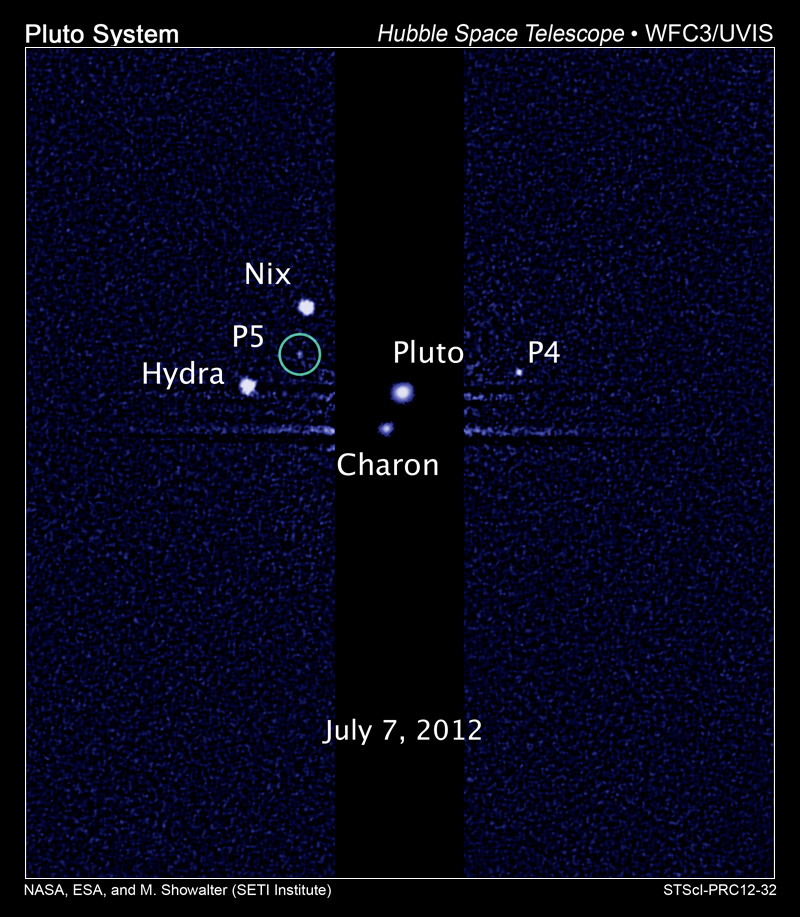Your Help Wanted to Name Two of Pluto's Moons

If you've ever wanted to leave your mark on the heavens, here's your chance.
Astronomers are asking for help in naming two newly discovered moons of Pluto, which currently go by the uninspired monikers P4 and P5. The tiny satellites were spotted by the Hubble Space Telescope in 2011 and 2012, respectively.
Pluto's three other known moons — Charon, Nix and Hydra — are named for Greek mythological characters associated with the underworld. The short list of names that interested members of the public can vote on for the new moons follow that same pattern, researchers said.
"The Greeks were great storytellers, and they have given us a colorful cast of characters to work with," Mark Showalter, a senior research scientist at the Search for Extraterrestrial Intelligence (SETI) Institute in Mountain View, Calif., said in a statement.
You can vote to name the moons on plutorocks.com until noon EST (1700 GMT) on Feb. 25. Write-in ballots are also encouraged.
P4 and P5 are both very small, with diameters of just 15 to 20 miles (20 to 30 kilometers). They were discovered by researchers associated with NASA's New Horizons mission, which is slated to fly by the dwarf planet in 2015. The team has been surveying Pluto and its environs for rings, small moons and other objects that might pose a danger to the fast-moving spacecraft.
Pluto was discovered in 1930. Its planethood was thrown into question when the International Astronomical Union came up with a new definition of "planet" in 2006. That year, Pluto was demoted to the status of "dwarf planet," a newly created category to describe many other objects in the Kuiper Belt, the ring of icy bodies beyond Neptune.
Get the Space.com Newsletter
Breaking space news, the latest updates on rocket launches, skywatching events and more!
Charon is by far the largest of Pluto's moons, measuring 648 miles (1,043 km) across. Nix and Hydra range between 20 and 70 miles (32 to 113 km) wide.
Follow Miriam Kramer on Twitter @mirikramer or SPACE.com @Spacedotcom. We're also on Facebook & Google+.
Join our Space Forums to keep talking space on the latest missions, night sky and more! And if you have a news tip, correction or comment, let us know at: community@space.com.

Miriam Kramer joined Space.com as a Staff Writer in December 2012. Since then, she has floated in weightlessness on a zero-gravity flight, felt the pull of 4-Gs in a trainer aircraft and watched rockets soar into space from Florida and Virginia. She also served as Space.com's lead space entertainment reporter, and enjoys all aspects of space news, astronomy and commercial spaceflight. Miriam has also presented space stories during live interviews with Fox News and other TV and radio outlets. She originally hails from Knoxville, Tennessee where she and her family would take trips to dark spots on the outskirts of town to watch meteor showers every year. She loves to travel and one day hopes to see the northern lights in person. Miriam is currently a space reporter with Axios, writing the Axios Space newsletter. You can follow Miriam on Twitter.










